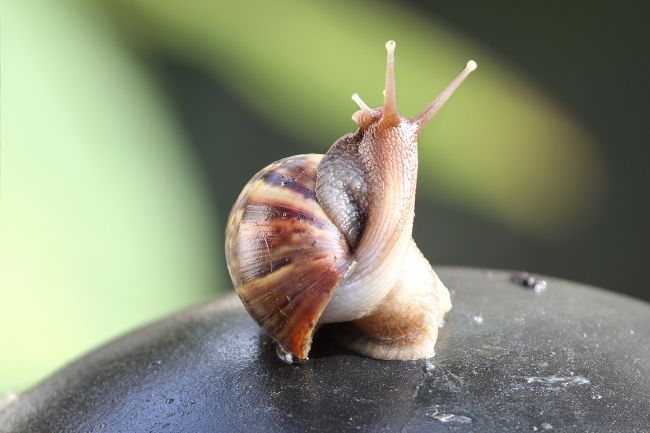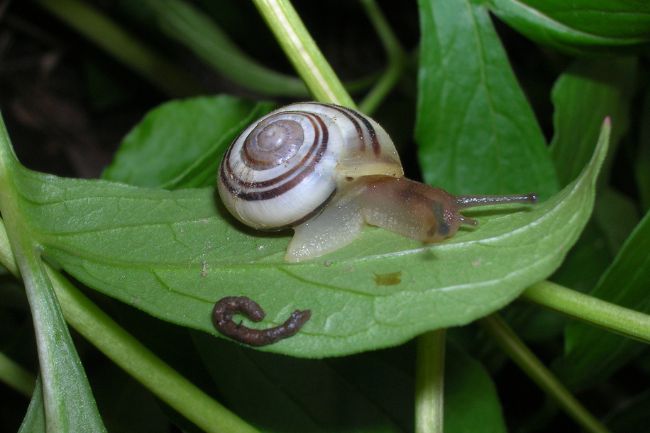Snails have a very similar digestive system to humans, with food entering their bodies through their mouths, traveling down to the stomach and eventually being expelled through the anus.
Contents
How do snails poop?

It may not seem like snails poop at all, as we rarely observe them doing so, and are unlikely to find their poop in our gardens, yet like all animals, snails need to expel waste from time to time.
Snails find food by using chemical signals in the air. They essentially smell food with the tentacles on their heads. This means they can travel surprising distances to get to their favourite snack.
Snails have a very similar digestive system to most mammals. On their heads they have a mouth. Within this opening is the radula. The radula is similar to a type of tongue, covered in large numbers of tiny teeth. They use the radula to scrape across the surface of their food, and slowly shred whatever they want to eat.
| Digestive System Component | Description | Additional Information/Explanation |
|---|---|---|
| Radula | A specialized feeding organ found in snails that consists of rows of microscopic teeth. The radula is used to scrape and rasp food particles from surfaces. | The radula is located inside the snail’s mouth and is unique to mollusks. It helps snails to consume a variety of plant material, algae, fungi, and even decaying organic matter. |
| Crop | A storage organ located near the esophagus where food is temporarily stored before entering the digestive gland. | The crop allows snails to store and regulate the flow of food into their digestive system. It aids in the digestion process by gradually releasing the ingested material for further processing. |
| Digestive Gland | An organ responsible for producing digestive enzymes to break down food and absorb nutrients. | The digestive gland secretes enzymes that help break down complex molecules into simpler forms that can be absorbed by the snail’s body. It plays a vital role in extracting nutrients from the ingested food. |
| Intestine | The part of the digestive system where the absorption of nutrients occurs. | The intestine is a long, coiled tube where the final stages of digestion take place. It is lined with specialized cells that absorb nutrients from the digested food and transfer them into the snail’s bloodstream. |
| Rectum | The terminal portion of the digestive system where waste material is temporarily stored before being eliminated as feces. | The rectum stores undigested materials and facilitates the elimination of waste from the snail’s body. It is located near the opening of the snail’s shell and is responsible for the formation and excretion of snail feces. |
Once the food has entered their mouth it travels down the esophagus. Here it can enter the crop, a kind of pouch where it can be stored. It then enters the stomach, where the majority of digestion takes place. In order to break down the food digestive fluids and enzymes are added to the mix.
Snails can eat a variety of different foods depending on the species. Many will eat largely vegetable matter, such as leaves and fruits, as well as decomposing animal matter such as feces. Some snails are predatory and will eat other animals.
Having been broken down within the stomach, any waste that hasn’t been absorbed into the snail’s body will enter the intestines. Finally, the poop will be expelled at the snail’s anus. Interestingly the snail’s anus isn’t at the end of its body, where we might expect to find it. Instead it is located under the shell.
The snail expels its waste into the mantle cavity, a gap below the shell. This is also its breathing hole, allowing air to reach its lungs. Air traveling in and out to help the snail breath, also helps to flush out the feces.
The poop will fall out from under the shell and land wherever the snail finds itself. Snails aren’t shy, and will happily poop whenever and wherever. However, due to the slow digestive processes within their bodies, they don’t poop very regularly, often going several weeks between needing to evacuate their bowels.
Also read: Snails & Their Shells: Everything You Need to Know
What does snail poop look like?

Snail poop doesn’t look that dissimilar to the poop of many other animals. It is often described as rope-like in appearance, and can look wet and slimy when it first emerges. Over time it will dry up and curl round, often breaking down and disappearing.
| Feces Characteristics | Description | Additional Information/Explanation |
|---|---|---|
| Appearance | Snail feces are typically small, cylindrical pellets or blobs. | The appearance of snail feces can vary depending on their diet and the moisture content of the environment. They are often dark in color due to the presence of undigested plant material and pigments. |
| Composition | Snail feces mainly consist of undigested plant matter and waste products. | Snail feces contain cellulose, hemicellulose, and other plant components that the snail was unable to fully digest. They also contain metabolic waste products and excess water absorbed during digestion. |
| Nutrient Recycling | Snail feces play a role in nutrient cycling and soil enrichment. | Snails contribute to the decomposition process by consuming plant material and excreting feces rich in organic matter. The feces break down further, releasing nutrients back into the environment, which can be utilized by other organisms or plants. |
| Fecal Pellet Disposal | Snails often deposit their fecal pellets in discrete locations. | Snails have specific spots or areas where they deposit their feces. This behavior helps maintain cleanliness within their habitat and prevents excessive accumulation of waste material. |
The colour of snail poop can vary a great deal depending on their diet. Common colours are green and brown, but it can be red and orange, if the snail is eating foods that contain these colours.
Does snail poop smell?
For a snail, their poop may indeed have a particular fragrance, but it isn’t really found in large enough quantities for humans to pick up on the scent.
Is snail poop good for plants?

Just like worm poop, snail poop is an excellent fertilizer for plants. This is in part because snails eat and digest plant matter, meaning that what comes out of their other end is highly composted and easy for plants to pick out what they need. Snail poop is high in essential nutrients such as nitrates, phosphates and potassium, all useful fodder for your plants.
In most cases, however, you aren’t going to be able to get hold of enough snail poop to make any real difference to your plants. The good news, however, is that wild snails are out there pooping into your plant pots, enriching the soil as they go. Individually their contribution is probably far too small for you to notice, but as a group they are making a big difference across the world.
If you’re lucky enough to have pet snails, then you can certainly recycle their poop into plant fertilizer, simply by adding it to the soil around your plant when you need to dispose of it. The good news is snail poop isn’t toxic or harmful, either to humans or pets, so you don’t need to worry about spreading it around.
No products found.
Also read: Keeping Snails as a Pet: Sea, Land & Exotic Species
Hungry snails
Snails spend much of their active time eating. When your favorite vegetables are their food of choice, this can seem somewhat frustrating. Yet, it’s not such a bad thing to have hungry snails around. As well as eating healthy plants, snails will often eat decaying plant materials, getting rid of waste that would build up over time and risk spreading diseases.
Through eating this waste they also help to cycle nutrients, by breaking down matter that plants find hard to digest, and making it into fertilising poop, from which they can easily access what they need. This nutrient cycling is an important part of our natural environment, and without it we would soon find ourselves overwhelmed by a whole different kind of waste.

